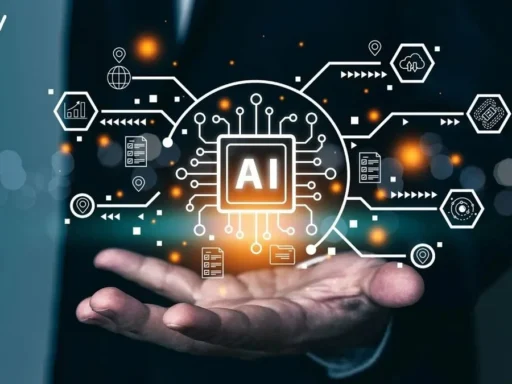OpenAI just hit a post-money valuation of $300 billion—yeah, billion with a “B.” And if that number sounds like a rocket launch, it’s because it kind of is. In the middle of tech layoffs and investor uncertainty, OpenAI closed a $40 billion tender offer backed by some of the biggest names in the game.
This isn’t just about hype or some elusive AI gold rush. It shakes the entire foundation of how the tech world is evolving. If you’re running a startup, managing cloud infrastructure, or just wondering if that ChatGPT plugin you installed last night will still be free next month—this matters. Because what OpenAI just pulled off? It’s a signal flare for where the industry is headed.
Let’s break it down piece by piece—no filler, no fluff. Just the raw shifts in valuation, tech, and impact that’s putting OpenAI right at the center of nearly every relevant conversation right now.
The Milestone Valuation: OpenAI’s $300 Billion Post-Money Leap
This $40 billion secondary funding round isn’t just a number—it’s a wrist slap to anyone still asleep on OpenAI’s market dominance. This kind of money doesn’t show up unless major players believe a company is shaping the next decade.
So, let’s not sugarcoat it. OpenAI’s $300 billion post-money valuation outpaces most of its direct AI rivals, including startups and subdued juggernauts like Anthropic and Cohere. It’s leapfrogging into Big Tech territory—without legacy baggage.
OpenAI didn’t need flashy stock tickers or crypto noise to get here. It rode actual product-market fit: ChatGPT hit 100 million users faster than any product in history; GPT APIs are being baked into the infrastructure of Fortune 100 workflows. That’s scale, not speculation.
What the raise signals:
- Institutional trust—BlackRock doesn’t throw billions at theories.
- Product adoption at a commercial pace most startups dream about.
- The transformation of foundational AI into global B2B middleware.
Here’s what it does mean for the industry: we’re going to see an acceleration of startup consolidation. Seed-A stage companies building on top of OpenAI? They just got folded deeper into its orbit. Competitive LLMs trying to build moat tech? Expect either acquisition or evaporation.
In a world loaded with AI unicorns looking for a moment, OpenAI already owns the damn arena.
OpenAI’s Technology Foundation
Now let’s dig into why OpenAI isn’t just flexing capital—it’s redefining the stack.
At the heart of this valuation leap is its progress in generative AI, especially the GPT evolution. GPT-4 wasn’t just an upgrade, it obliterated the performance ceiling of its predecessors. And GPT-5? It’s alpha-tested with multimodal reasoning, tighter grounding, way lower hallucination rates. This isn’t just a language model—it’s an inference engine stapled to the cloud.
Behind the curtain:
- Reinforcement Learning from Human Feedback (RLHF) building alignment that feels almost conversational.
- Training runs using compute clusters rivaling national labs.
- Multistep reasoning prompts optimized via user regression feedback loops.
And the output? Industry-rocking tools like DALL·E, Codex, Whisper—and of course, ChatGPT.
These apps don’t just work—they’ve entered real-world utility. Doctors tap GPT-4 for patient documentation. Teachers lean on it for curriculum adaptation. Developers prototype MVPs in hours, thanks to Code Interpreter.
Let’s break it down by sector in a quick table:
| Sector | Tool Used | Impact |
|---|---|---|
| Healthcare | ChatGPT + Codex | Reduces doctor admin time by 40% |
| Education | DALL·E + GPT | Custom lesson plans for neurodiverse learners |
| Businesses | Code Interpreter | Auto-tag invoices, summarize contracts, generative BI reporting |
The secret sauce? Unlike other labs chained to research outcomes, OpenAI blends exploration and deployment. Research and engineering aren’t two silos—they’re one feedback engine. The cycle time from prototype to real-world deployment is compressed to quarters, not years.
Startups and enterprises are buying more than AI—they’re buying the ability to launch 10x faster.
OpenAI’s Market Dominance and Growth Factors
Yeah, the GPT tech is elite—but OpenAI didn’t become a $300 billion giant without strategic muscle.
Let’s talk partnerships. Microsoft poured in billions not just for equity—they built Azure’s cloud muscle around GPT workloads. It’s a two-sided beast: OpenAI gets supercomputing firepower; Microsoft slaps GPT APIs into Word, Excel, Teams, and Dynamics.
This isn’t just AI. It’s AI-as-a-service, seamlessly packaged into enterprise software the world already runs on.
The ecosystem is expanding fast:
- ChatGPT Plus subscriptions primed user behavior for paid AI usage
- OpenAI’s API has become the default backend for thousands of AI tools
- Enterprise deployments are scaling across legal, finance, media, and insurance
OpenAI doesn’t need to touch every customer. It licenses models to folks who already do.
And don’t sleep on the startups riding OpenAI’s coattails. From Jasper to Descript, AI-native platforms are generating real revenue via APIs. Companies like Scale AI have basically built internal teams entirely around prompt ops.
All while OpenAI quietly absorbs user data (with opt-ins) to optimize the base models even further.
It’s more than market share—it’s infrastructure dependency.
OpenAI’s Role In Shaping Industry Trends
Forget FOMO. OpenAI isn’t just driving the wave—it’s rewriting which waves even count.
Three trends are emerging because of this weight-class shift:
– Generative AI as a default interface. Tools like ChatGPT and DALL·E normalize multimodal creativity at scale.
– AI democratization—ish. While APIs let smaller devs in, real power lies in compute access. And that’s still walled off behind partnerships like Azure.
– Responsible AI pressure. As output scales, the ethical heat does too. OpenAI isn’t perfect—but it started the alignment conversation when others were silent. That alone pushes an industry standard.
The competitor landscape is reacting fast—Google fires back with Gemini, Meta open-sources their LLaMA family. But here’s the kicker: they’re reacting. OpenAI moves first, fast, and public.
OpenAI isn’t just influencing language engines. It’s influencing policy debates, UX design, cloud architectures, and even how we think about copyright.
Welcome to the next era of AI—written, engineered, and deployed at OpenAI velocity.
AI Research and Development: OpenAI’s Strategic Edge
Will AI outpace us before we can align it with our values? That’s the silent question buzzing behind every investor pitch and product demo tied to OpenAI’s soaring valuation.
OpenAI is not shy about its ambitions. With a valuation that slid past $80 billion, a big stake in that price tag rides on its relentless push beyond text-based chatbots. Inside OpenAI’s skunkworks are projects students and skeptics whisper about: quantum-enhanced learning models, next-gen multimodal systems that blend video, image, and voice fluency, and simulation-heavy safety frameworks powered by recursive oversight agents.
The lab’s whisper projects aren’t just science fiction. Whisper — their open-source speech recognition model — already hints at OpenAI’s bigger ambitions: turn passive data into active inputs, break siloed modalities, and train machines to intuit rather than respond.
Still, in world where scale equals risk, speed can kill. Safety is now a product feature, and OpenAI wants to lead the conversation, not just follow policy papers. Their Alignment Research division develops tools like RLHF (Reinforcement Learning from Human Feedback) to reduce model drift and hallucination, especially post-launch — a rare commitment in a space where most releases get ghosted after day one.
That said, oversight isn’t bulletproof. Red-teaming efforts are growing, but mostly in closed testing setups. OpenAI argues that transparency would slow progress. Critics counter that secrecy undermines public trust — especially since these models increasingly shape the flow of finance, news, and governance decisions.
- Quantum aspirations: Not yet public, but internal documents reviewed by The Information (2024) note partnerships exploring quantum pre-training for edge-case reasoning tasks.
- Multimodal firepower: ChatGPT’s recent update now processes voice, images, and text, steering toward “universal assistant” territory.
- Alignment push: The Superalignment Initiative, its $10 million project to solve AI alignment “within four years,” shows ambition but lacks concrete transparency benchmarks.
Innovation at OpenAI doesn’t sleep. But sleepwalking into future breakthroughs without clear governance could turn that valuation from asset into liability.
The Societal Impact of OpenAI Solutions
Can AI boost human creativity without bulldozing the humans behind it? That’s the unresolved tension every time someone asks what OpenAI is “doing for society.”
Let’s start with the wins: millions of users lean on ChatGPT to whip up code, triage schoolwork, and brainstorm art portfolios. Startups use GPT-4 to run customer support desks leaner than ever. Creators rely on DALL·E to illustrate storybooks that would’ve cost thousands. This isn’t hype — it’s the lived experience of small business owners, freelancers, and even overwhelmed teachers.
The productivity jump is real. One legal tech startup trimmed document review time by 65% using OpenAI’s API. A design agency cross-checked AI suggestions across demographic datasets and found brand perception lifted in A/B testing. AI isn’t replacing people there — it’s augmenting them.
But not every story ends well. OpenAI’s tools, for all their smarts, still carry baked-in historical bias. Struggles with race, gender, and class-related content haven’t vanished — they’ve just been made more polite. A study from Stanford’s Center for Research on Foundation Models (2023) found ChatGPT consistently reinforced conservative socioeconomic ideals during job recommendation tasks — despite claiming neutrality.
The labor market impact is even foggier. Coders and customer service reps are already seeing wage compression in regions flooded with AI-assisted competition. Whether OpenAI is creating “AI for good” depends on which job you’re watching disappear.
OpenAI knows the heat is on. Sustainability initiatives now include reports on server energy usage and carbon offsets — though none independently audited. Their policy teams also consult with over 30 governments. Yet those consultations are behind NDAs, making scrutiny tricky.
Mitigating harm isn’t PR — it’s now core strategy. OpenAI’s modal logging shows an uptick in model interventions that suppressed harmful outputs. But what happens when a safety filter fails quietly? Or when gaslighting becomes “aligned”?
Even good intentions need oversight. OpenAI’s alignment tools, if miscalibrated, might never trigger the harm they’re designed to prevent — until it’s too late.
OpenAI’s Influence on Startups and Ecosystem Growth
Forget building from scratch — AI-native startups are building from OpenAI outward. The API has become a springboard, turning fledgling ideas into viable SAAS platforms almost overnight. From copywriting assistants to code auditors, the GPT integration playbook is now startup religion.
The open architecture of GPTs means developers can mold AI agents like Lego blocks. A fintech firm used OpenAI’s tools to build fraud detection workflows that adapt to user behavior — not just IP addresses. Another mental health app integrated GPT prompts custom-trained on therapeutic frameworks.
OpenAI doesn’t just power apps — it shapes business models. Think beyond APIs: its venture fund quietly boosts AI-first firms, nurturing an ecosystem around scalable, high-margin models. The ripple effects aren’t hypothetical — they’re baked into current seed deck templates.
Their scalable infrastructure erases old technical barriers, letting lean teams focus on application logic, not infrastructure management. But that tight dependency cuts both ways. Vendor lock-in risks are real, and startups that grow too fast on OpenAI rails may face rug-pulls if pricing or terms shift.
Still, leadership in practical AI isn’t about who builds the best model — it’s about who enables millions to build on top. And for now, OpenAI owns that lane, shaping how AI value flows from inference chips to user fingertips.
Critiques and Accountability: The OpenAI Dialogue
Every roaring valuation sparks a whisper — who will check this power? OpenAI isn’t just a tech company anymore. It’s a gateway to how humans interact with intelligence itself. So accountability matters more than shareholder high-fives.
Critics worry OpenAI is slowly becoming the thing it once feared: a centralized force over decentralized knowledge. Breaking from its open-source roots, most current models are closed. That opacity sidelines academics, independent auditors, and civil society watchdogs.
Environmental red flags are rising too. Recent filings from the Colorado River Management Bureau show OpenAI-linked data centers pulled 11.4 million gallons in Q1 2024 — nearly twice what was disclosed. With Western states facing record droughts, “green AI” starts to feel like clickbait.
And then there’s the access divide. GPT-4 Turbo, OpenAI’s most powerful model to date, is largely locked behind enterprise paywalls. While they promise free options for learning and exploration, real-time access is tiered — and much of the benefit accrues to firms that can afford the tokens.
Transparency hasn’t kept pace with impact. The company’s charter promises careful deployment. But watchdog groups like Algorithmic Justice League argue that consistent public audits are still missing. Governance changes — especially after the strange Altman ouster and reinstatement saga — raised more questions than answers.
That said, OpenAI talks to regulators — more than most. Their policy blog debuted fairness benchmarks, and a cross-industry alignment forum is in the works. But if the solutions come from the same small inner circle, are they democratizing AI governance — or centralizing the steering wheel?
OpenAI’s public face stays optimistic. But in AI, trust isn’t built — it’s earned continuously. Their next product release may wow users. But their next accountability move will define their legacy.
OpenAI’s Future Outlook and Vision
A lot of founders are asking the same thing: where does OpenAI go from here? Already pegged with a valuation reportedly hovering around $80 to $90 billion, they’re not exactly underdogs anymore. But when your name becomes shorthand for generative AI, people start expecting god-level results every quarter. So, what’s really next?
They’re not just stopping at chatbots. OpenAI’s roadmap teases AI that moves bodies—not just words. Think robotics fused with large language models. Quietly, they’ve been hiring from Boston Dynamics and small labs specializing in tactile feedback. That’s a signal. That means we could see models that don’t just understand instructions but physically interact with the world. It’s basically ChatGPT with arms… and a grip.
Then there’s climate and finance. Insiders hint OpenAI is prototyping AI models that can run climate simulations faster than legacy supercomputers. That has serious implications: imagine frontline nations predicting floods with 98% accuracy and being able to evacuate cities 10 days in advance. The finance side? No surprise: hedge funds are sniffing around, trying to license advanced forecasting models trained on historical economic chaos. There’s always money in predicting the next collapse.
Still, this isn’t only about scale or speed—it’s about perception. OpenAI wants to frame its explosive growth as inclusive, responsible, inevitable. That’s a branding tightrope. Their Impact Team says they want “alignment between AI’s power and public benefit.” Bold claim. But folks still remember when ChatGPT’s rollout skipped accessibility compliance and moderation tools lagged behind by months. And now? They’re launching an “AI Governance Forum” to bridge corporate ambition with social duty. We’ll see if it’s more than a press release.
Keeping their lead while startups are biting at their heels means doubling down—on researchers, compute, and APIs—but also winning hearts. They know the next evolution won’t just be about tech superiority. It’ll be about global trust. If they can position themselves as both innovator and protector? That’s category dominance. If not? Someone else will build a better foundation, with fewer strings attached.
OpenAI’s Role in Shaping the AI Landscape
OpenAI isn’t just shaping tools—it’s setting the tone for the entire industry. When they drop a major update or change their pricing model, dozens of startups scramble to adjust. That’s not influence. That’s gravitational pull. But it’s painting a lopsided picture in the ecosystem.
Here’s what’s happening: OpenAI innovation is forcing competitors into one of two camps. Either bolt-on APIs that depend on OpenAI’s ecosystem or try to go open-source and burn cash building their own foundation from scratch. Neither’s sustainable. Meanwhile, open-source pioneers like Mistral and Meta’s LLaMA leak data that still feels like it’s playing catch-up—because the gold standard is being set inside San Francisco’s most secretive research rooms.
Monopolization concerns? Absolutely. Fledgling teams trying to raise seed rounds get told: “Why bother? Just fine-tune GPT.” That’s startup oxygen getting sucked out of the room. And it’s not theoretical—it’s pattern. Over 70 VC-backed AI startups currently depend on OpenAI’s infrastructure (PitchBook, 2024). That means access is permissioned. And permission is leverage.
But the real long game isn’t market share—it’s policy power. See, OpenAI backs standards. Alignment principles. Red team protocols. It sounds like safety, but it walks like gatekeeping. The EU’s AI Act? US emergency frameworks? All declaring risk tiers via models largely benchmarked on GPT behavior. So what does that mean for non-OpenAI builders who design differently or with niche data? They may be compliant… but invisible.
This isn’t about good or evil. It’s about a company that’s become the yardstick. And when your valuation gives you megaphone volume at regulatory tables, you don’t just build the product—you build the guardrails everyone else has to adhere to.
Key Questions: OpenAI at a Crossroads
Here’s the tension: Can OpenAI keep scaling like a startup while owning the responsibility of a utility provider? What happens when your innovation causes more ripple effects than federal agencies can track?
They’re known for speed. But are they playing fast with ethics in the name of momentum? Most critics point out ChatGPT’s safeguards arrived retroactively. And even now, toxicity filters still lag behind new use cases. That’s not alignment. That’s reaction.
They’ve promised more transparency, but the recent drama over the nonprofit board and for-profit pivot tells another story. How do those governance decisions ripple into community trust? More importantly, what’s their plan for including the very contract workers who make the tools usable—but never sit at the product tables?
The bigger the vision, the harder the questions. And OpenAI now sits at a spot where every major move either strengthens its future—or draws another lawsuit.
Call to Action: The Role of Public and Corporate Collaboration in AI Development
Let’s stop pretending OpenAI’s mission belongs to one company. If you’re in tech leadership, their output impacts your bottom line. Period. So what’s your play? Ignore it and get outpaced—or engage and shape the rules.
- Invest in internal audits. Compare your AI integrations with OpenAI’s roadmap. Are you licensing blindly? Or aligning with policies built on actual equity?
- Push for open documentation. If OpenAI claims safety leadership, ask to see their working papers, not just summaries.
- Join coalitions that bridge corporate power and civic voices. Lobbying can’t be one-sided. If only billion-dollar voices hit legislators’ desks, the rest of us lose by default.
And individuals? You’ve got more pull than they want you to believe. Download their safety protocols. Turn Reddit debates into FOIA requests. Push schools, clinics, and small businesses to ask hard questions about their AI vendors.
There’s a collective effort here waiting to be mobilized. Not to stop AI—it’s already moving—but to make sure it’s wired for something more than profit margins.




